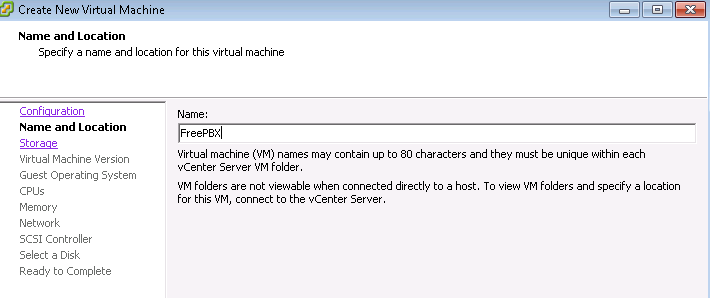Next we need to setup a VOIP provider or a (Trunk) to make inbound and outbound calls. In the demo, we will be using callcentric. You can create a free account to test calls to other callcentric members and the tell me service (888-247-2425) call for free on callcentric using 7771234567
So, lets get started:
Due to copyright, I am going to past a link to the setup guide below:
http://www.callcentric.com/support/device/freepbx
Use the version 1.8 guide.
Below is a screen shot of the outbound rule for callcentric:
The above screen shot has the prefix "9". This is useful if you have multiple trunks and want to establish which you are using by setting up a prefix. To gain access to the callcentric trunk, we will dial 9 then the number. For example 918005551212
The "." represents anything that is sent on the trunk will be passed to callcentric. The technical term would be dial plan.
Wednesday, January 9, 2013
Sunday, January 6, 2013
Free PBX - Web GUI - Setup/Extension Setup
The next step in getting everything running is logging into the web interface.
Open a web browser and point to the IP of the PBX install. You had the option of assigning a staic IP or using DHCP. If you chose DHCP and have no clue what the IP address it, log into the free PBX console using the username ROOT and the password you created.
Type IFCONFIG this will give you the IP address of the system.
After you open the interface, you should see a prompt to create a password. This password is used for the web interface only.
Go ahead and log into the interface using the username and password you created in the last step.
You will then see this screen:
System status gives us a brief overview of whats happening right now on the freepbx box.
We are first going to create an extension. To do this, choose applications in the top link bar then choose extensions. You will be prompted with the following:
For the demo, we will be using the X_lite software provided by counterpath. Direct link: http://www.counterpath.com/x-lite.html
Anyway, click submit. Below is a screenshot of the extension I created. Necessary fields are Display Name, Outbound CID, secret (sip password)
The secret or password I created was 1000abc
After the extension has been created, you can now configure your x_lite phone. Below are screen shots of that.
After xlite has been installed, add a new account:
User ID is the extension you created, domain is the IP of the free pbx box, password is the "secret" you created. Display name is what shows up on the internal caller ID.
To test your setup, you can dial *43 to perform an echo test.
Open a web browser and point to the IP of the PBX install. You had the option of assigning a staic IP or using DHCP. If you chose DHCP and have no clue what the IP address it, log into the free PBX console using the username ROOT and the password you created.
Type IFCONFIG this will give you the IP address of the system.
After you open the interface, you should see a prompt to create a password. This password is used for the web interface only.
Go ahead and log into the interface using the username and password you created in the last step.
You will then see this screen:
System status gives us a brief overview of whats happening right now on the freepbx box.
We are first going to create an extension. To do this, choose applications in the top link bar then choose extensions. You will be prompted with the following:
For the demo, we will be using the X_lite software provided by counterpath. Direct link: http://www.counterpath.com/x-lite.html
Anyway, click submit. Below is a screenshot of the extension I created. Necessary fields are Display Name, Outbound CID, secret (sip password)
The secret or password I created was 1000abc
After the extension has been created, you can now configure your x_lite phone. Below are screen shots of that.
After xlite has been installed, add a new account:
User ID is the extension you created, domain is the IP of the free pbx box, password is the "secret" you created. Display name is what shows up on the internal caller ID.
To test your setup, you can dial *43 to perform an echo test.
Free PBX - Initial Setup - VM, OS install
This first post is a step by step install guide for Free PBX.
In the demo, we will be using ESXI 5.1.0 as the virtual host and an Iomega Storcenter ix4 as the data store.
In the next couple of Days I will create a demo of how to setup ESXI.
But for now....
To get started with Free PBX, we need to download the latest ISO (Live Installer) from the website. The direct link is http://www.schmoozecom.com/distro-download.php
I have downloaded the 64 Bit stable version. The name of the file is FreePBX-2.210.62-3-x64_64-Full-1357257745.iso
After downloading the ISO image, we will create a new virtual machine in VMWare. Start by adding a virtual machine then follow the settings below:
Custom
I have named the Virtual Machine FreePBX but you can name it whatever you like:
Click next then choose a datastore to save the VM. - I have created an ISCSI target using the Iomega NAS. You can use datastore1 if you do not have an external device.
Choose Virtual Machine Version: 8 for maximum functionality.
Click Next:
The guest operating system is Linux. I chose Red Hat Enterprise Linux 6 (64-bit) Any linux option on the version dropdown should work.
Click Next.
I have chosen 4 virtual sockets: 1 virtual socket will work fine - the Free PBX distro does not take a lot of processing power for Small to Medium installs.
Click Next:
In the demo, we have chosen 4 gb of Ram. 1 - 2 GB is sufficient for small to medium installs.
Click Next.
You will need at least one NIC for network connectivity - Trunk Providers/Phone extensions - Basically one NIC to make anything work.
Click Next:
Choose VMware Paravirtual - Other options can/will degrade performance.
Click Next:
Choose create a new virtual disk
Click next:
Specify the size of the disk in GB. I have chosen 90 GB for the demo, 10 is plenty of space for small installs. Additional space will be needed for VM, call recording, Greetings, etc.
Click next:
On the advanced options page, click next.
Click Next. Check the "Edit the virtual Machine settings before completion"
Click Next:
For the demo, I have selected "reserve all quest memory (all locked)" This enhances ISCSI performance by not storing the linux swap file on the SAN or NAS device. Instead, all memory is allocated when the virtual machine is started.
Click Finish:
The next step is to start up the virtual machine.
Open the console for the virtual machine we just created and click the green start button.
After the console is open, click the CD icon with a wrench. This will let us specify the CD (ISO in our case) for installing the operating system (free PBX).
Click open a file on the local disk. Browse to where you saved the FreePBX-2.210.63-2-x86_64-Full-1357257745 file then choose open.
After you have clicked open, click control + alt + insert on your keyboard, this will reboot the virtual machine and start booting the installer. The screen should look similar to the following after the VM has started to spin up the ISO.
You will then be prompted which version of asterisk and free pbx you would like to install. Choose the top option. (Full Install).
Then you will see this screen (network configuration)
For the demo I have used the static address of 10.5.0.1 / subnet 255.0.0.0 / gateway 10.0.0.1 However, feel free to use dynamic IP configuration (DHCP). After you have configured the network settings, choose OK.
The next screen in time zone selection.
After choosing the time zone, select OK.
You are prompted to create a password for the "root" user.
After entering the password, the installer for CentOS creates the filesystem. This takes some time depending on the size of the disk you configured.
The next step is package installation, I have skipped forward in screenshots... to 72%
After the packages are installed, the system will reboot then you should (hopefully) :) be prompted with this screen to log in:
That completed the install section, please see the next post :)
In the demo, we will be using ESXI 5.1.0 as the virtual host and an Iomega Storcenter ix4 as the data store.
In the next couple of Days I will create a demo of how to setup ESXI.
But for now....
To get started with Free PBX, we need to download the latest ISO (Live Installer) from the website. The direct link is http://www.schmoozecom.com/distro-download.php
I have downloaded the 64 Bit stable version. The name of the file is FreePBX-2.210.62-3-x64_64-Full-1357257745.iso
After downloading the ISO image, we will create a new virtual machine in VMWare. Start by adding a virtual machine then follow the settings below:
Custom
I have named the Virtual Machine FreePBX but you can name it whatever you like:
Click next then choose a datastore to save the VM. - I have created an ISCSI target using the Iomega NAS. You can use datastore1 if you do not have an external device.
Choose Virtual Machine Version: 8 for maximum functionality.
Click Next:
The guest operating system is Linux. I chose Red Hat Enterprise Linux 6 (64-bit) Any linux option on the version dropdown should work.
Click Next.
I have chosen 4 virtual sockets: 1 virtual socket will work fine - the Free PBX distro does not take a lot of processing power for Small to Medium installs.
Click Next:
In the demo, we have chosen 4 gb of Ram. 1 - 2 GB is sufficient for small to medium installs.
Click Next.
You will need at least one NIC for network connectivity - Trunk Providers/Phone extensions - Basically one NIC to make anything work.
Click Next:
Choose VMware Paravirtual - Other options can/will degrade performance.
Click Next:
Subscribe to:
Comments (Atom)































